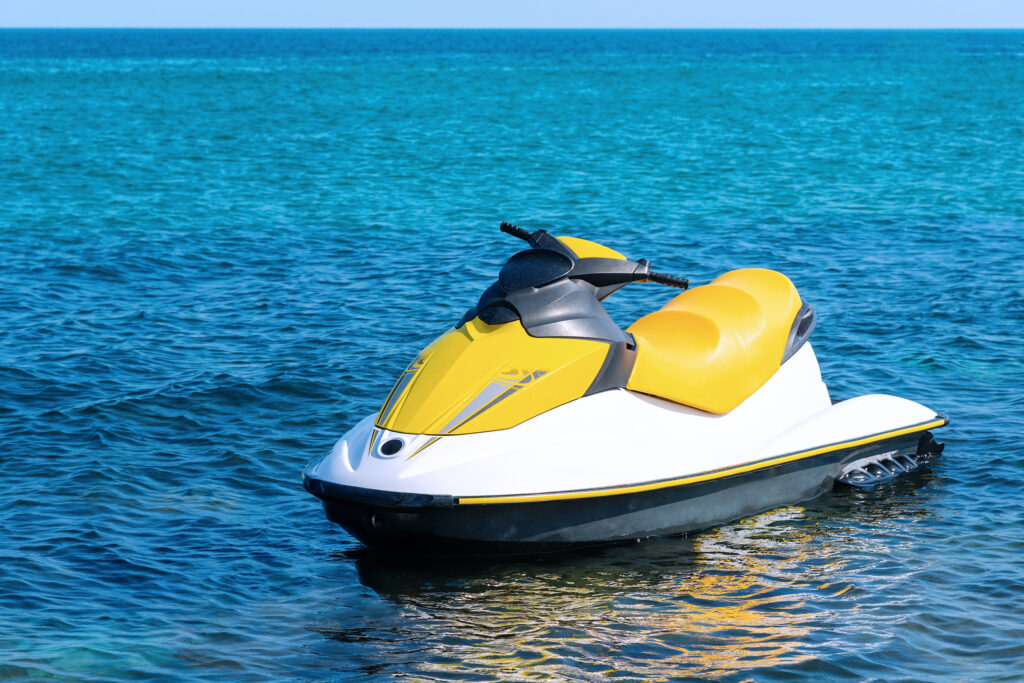Jet skis are the ultimate on-water adventure, but how are they driven? Do they have propellers?
Jet skis don’t have traditional propellers in the way that a ship or boat does – they’re powered by a jet propulsion engine. However, one feature of this engine is the rotating fan blades that ‘suck in’ the water used to propel the jet ski forwards. This water is then ejected at high speed, producing thrust.

Read on to learn more about jet skis and how they actually work.
Putting the ‘Jet’ in Jet Ski
Jet skis are often referred to as motorcycles that can ride on the water. While the comparison is true in how they’re driven and seated, it ends when it comes down to the engine of the vehicle.
While a motorcycle runs on a traditional combustion engine, a jet ski is something else entirely. However, where other seafaring vessels use propellers and driveshafts for propulsion, a jet ski doesn’t.
Instead, a jet ski relies on that which is within its title: a jet! We’re not talking about the kind of jets found on aircraft, but a water propulsion jet system.
On the front of a jet ski is a large intake system, through which water is sucked in. It’s pulled inwards by a bladed fan system – similar to propellers, but not exactly the same.
In fact, the naming convention of this equipment tells you everything you need to know. It’s referred to as an impeller, which is the polar opposite of a propeller.
Once the water has been sucked into the engine, it’s powered through a water pump, and ejected at high speed from the rear of the craft.
It’s this ejection that thrusts the jet ski – or personal watercraft – forwards in the water. It’s also how the vessel is steered, given that the handlebars are linked to the movable jet at the rear of the vehicle.
This is also a huge factor in the maneuverability of the jet ski, as the faster the vehicle is going, the more agile its turns can be. The jet ski needs that jet of water to move effectively, so turning at slower speeds is almost certainly not going to happen.
At high speeds, the jet can propel around fifty gallons of water per second. This water bursts from the jet nozzle with around eight hundred pounds of force.
It’s incredibly powerful.
So incredible, in fact, that it’s one of the leading causes of injury when riding a jet ski. Typically, if a passenger falls from the back of a jet ski, they’re likely to land right in the path of the powerful jet.
This has been known to cause internal organ and orifice damage, as the explosive force of the jet slams into the body. It’s extremely unlikely for the rider to be damaged by this jet, as the stream would cease as soon as they release the throttle upon falling off.
Harmless Fun?
While jet skis are seen as adventurous, exciting, and exhilarating, they are quite dangerous. There are thousands of incidents each year involving crashes, explosions, injury, or fires.
The incidents are compounded when passengers climb aboard the jet ski, too. There are some modern jet skis that can accommodate up to three riders in total.
We recently published an article discussing how easy it is for jet skis to explode, and it happens more frequently than you might think.
There’s a reason you’re legally required to have insurance and safety equipment across many different states. Jet skis, like cars, have to be regulated and are subject to laws and rules.
You’re essentially sitting atop a fiberglass rocket that’s powered by an engine suited to most small cars. You can’t brake properly, and you’re held in by nothing more than the strength of your grip.
One of the most powerful jet skis in the world is the supercharged Kawasaki Jet Ski Ultra 310LX. This particular watercraft boasts a 1.5-liter engine, complete with a supercharger and intercooler system.
It’s massively powerful and considerably expensive. It sits atop the list as one of the most valuable jet skis on the market, and it’ll cost you around eighteen thousand dollars brand new.
We’re not saying jet skis should be avoided at all. If that were to be true, motorcycles should also be dismissed as a safe and sensible mode of transport.
You just need to be careful and responsible when riding one and know your limits, and abilities.
